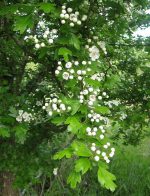 Common hawthorn is a thorny deciduous shrub or small tree native to Europe, northwest Africa and western Asia It was introduced into the US and has become invasive in some areas due to its prolific seed production and wide dissemination by wildlife. Also known as mayblossom and English hawthorn, plants grow 10-30’ tall, are densely branched, and have gray- brown bark with vertical orange fissures. The glossy green leaves are 1-1.5” long and have 3-7 deeply incised lobes. Clusters of 5-25 small white, five-petaled flowers have numerous red stamens and an unpleasant odor. They appear in late spring and give way to a one seeded red berry like fruit that is attractive to birds and other wildlife that aid in seed dissemination. Common hawthorn grows well in full sun to partial shade and is tolerant of a wide variety of soils include acid and alkaline ones. It also tolerates drought and pollution. USDA Hardiness Zones 4-8
Common hawthorn is a thorny deciduous shrub or small tree native to Europe, northwest Africa and western Asia It was introduced into the US and has become invasive in some areas due to its prolific seed production and wide dissemination by wildlife. Also known as mayblossom and English hawthorn, plants grow 10-30’ tall, are densely branched, and have gray- brown bark with vertical orange fissures. The glossy green leaves are 1-1.5” long and have 3-7 deeply incised lobes. Clusters of 5-25 small white, five-petaled flowers have numerous red stamens and an unpleasant odor. They appear in late spring and give way to a one seeded red berry like fruit that is attractive to birds and other wildlife that aid in seed dissemination. Common hawthorn grows well in full sun to partial shade and is tolerant of a wide variety of soils include acid and alkaline ones. It also tolerates drought and pollution. USDA Hardiness Zones 4-8
The following natives are recommended alternatives:
Serviceberries (Amelanchier spp)
Three Amelanchiers are noteworthy alternative natives: Allegheny serviceberry ( A. laevis), common service berry or shadbush (A. arborea), and shadblow (A. Canadensis). All are deciduous small trees native to moist habitats in Eastern US, and have attractive clusters of white flowers in spring. They vary, however, in hardiness: A. laevis is hardy in USDA zones 4-8, A. arborea in zones 4-9, and A. canadensis in Zones 4-7.
Fringe Tree (Chionanthus virginicus)
Flat clusters of creamy-white flowers appear in the spring on this small to medium sized deciduous tree and are followed by yellow to red fall color. Native to New Jersey, Kentucky, and Missouri, south to Florida and Texas, fringe tree grows in woodland edges, rock outcroppings, and roadsides. USDA Hardiness Zones 4-9
Cock-Spur Hawthorn (Crataegus crus-galli)
Growing 10-25’ tall this large shrub or small tree has a horizontal branching structure and domed clusters of white flowers in spring tht give way to waxy red berries in late summer. The glossy green leaves are oval and turn bright red to burgundy in the fall. Native to woodland borders, rocky slopes, savannas and cleanings from Nova Scotia to Ontario south to Florida and Texas. USDA Hardiness Zones 3-8
Blackhaw (Viburnum prunifolium)
This deciduous shrub or small tree is native to moist areas from Connecticut to Michigan, south to Florida and Texas. It has glossy dark green leaves that turn red and purple in the fall, flat topped clusters of white flowers in spring, and edible fruits good for jams and preserves. USDA Hardiness Zones 3-9
Photo Credit: Lisa Jarvis